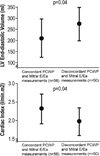Tissue Doppler imaging in the estimation of intracardiac filling pressure in decompensated patients with advanced systolic heart failure
- PMID: 19075104
- PMCID: PMC3169300
- DOI: 10.1161/CIRCULATIONAHA.108.779223
Tissue Doppler imaging in the estimation of intracardiac filling pressure in decompensated patients with advanced systolic heart failure
Abstract
Background: The ratio of early transmitral velocity to tissue Doppler mitral annular early diastolic velocity (E/Ea) has been correlated with pulmonary capillary wedge pressure (PCWP) in a wide variety of cardiac conditions. The objective of this study was to determine the reliability of mitral E/Ea for predicting PCWP in patients admitted for advanced decompensated heart failure.
Methods and results: Prospective consecutive patients with advanced decompensated heart failure (ejection fraction < or =30%, New York Heart Association class III to IV symptoms) underwent simultaneous echocardiographic and hemodynamic evaluation on admission and after 48 hours of intensive medical therapy. A total of 106 patients were included (mean age, 57+/-12 years; ejection fraction, 24+/-8%; PCWP, 21+/-7 mm Hg; mitral E/Ea ratio, 20+/-12). No correlation was found between mitral E/Ea ratio and PCWP, particularly in those with larger left ventricular volumes, more impaired cardiac indexes, and the presence of cardiac resynchronization therapy. Overall, the mitral E/Ea ratio was similar among patients with PCWP >18 and < or =18 mm Hg, and sensitivity and specificity for mitral E/Ea ratio >15 to identify a PCWP >18 mm Hg were 66% and 50%, respectively. Contrary to prior reports, we did not observe any direct association between changes in PCWP and changes in mitral E/Ea ratio.
Conclusions: In decompensated patients with advanced systolic heart failure, tissue Doppler-derived mitral E/Ea ratio may not be as reliable in predicting intracardiac filling pressures, particularly in those with larger LV volumes, more impaired cardiac indices, and the presence of cardiac resynchronization therapy.
Figures






Comment in
-
Recalibrating the barometer: is it time to take a critical look at noninvasive approaches to measuring filling pressures?Circulation. 2009 Jan 6;119(1):13-5. doi: 10.1161/CIRCULATIONAHA.108.823591. Epub 2008 Dec 15. Circulation. 2009. PMID: 19075101 No abstract available.
-
Letter by Nagueh et al regarding article, "Tissue Doppler imaging in the estimation of intracardiac filling pressure in decompensated patients with advanced systolic heart failure".Circulation. 2009 Aug 18;120(7):e44. doi: 10.1161/CIRCULATIONAHA.109.856187. Circulation. 2009. PMID: 19687363 No abstract available.
-
Letter by Ogunyankin regarding article, "Tissue Doppler imaging in the estimation of intracardiac filling pressure in decompensated patients with advanced systolic heart failure".Circulation. 2009 Aug 18;120(7):e45. doi: 10.1161/CIRCULATIONAHA.108.846477. Circulation. 2009. PMID: 19687364 No abstract available.
-
Letter by Galderisi and Esposito regarding article, "Tissue Doppler imaging in the estimation of intracardiac filling pressure in decompensated patients with advanced systolic heart failure".Circulation. 2009 Aug 18;120(7):e46. doi: 10.1161/CIRCULATIONAHA.109.852012. Circulation. 2009. PMID: 19687365 No abstract available.
-
Letter by Dokainish regarding article, "Tissue Doppler imaging in the estimation of intracardiac filling pressure in decompensated patients with advanced systolic heart failure".Circulation. 2009 Aug 18;120(7):e47. doi: 10.1161/CIRCULATIONAHA.109.854547. Circulation. 2009. PMID: 19687366 No abstract available.
-
Letter by Lancaster et al regarding article, "Tissue Doppler imaging in the estimation of intracardiac filling pressure in decompensated patients with advanced systolic heart failure".Circulation. 2009 Aug 18;120(7):e48. doi: 10.1161/CIRCULATIONAHA.109.858423. Circulation. 2009. PMID: 19687367 No abstract available.
References
-
- Haskell RJ, French WI. Accuracy of left atrial and pulmonary artery wedge pressure in pure mitral regurgitation in predicting ventricular enddiastolic pressure. Am J Cardiol. 1988;61:136–141. - PubMed
-
- Keogh AM, Baron DW, Hikie JB. Prognostic guides in patients with idiopathic or ischemic dilated cardiomyopathy for cardiac transplantation. Am J Cardiol. 1990;65:903–908. - PubMed
-
- Stevenson WG, Stevenson LW, Middlekauff HR, Fonarow GC, Hamilton MA, Woo MA, Saxon LA, Natterson PD, Steimle A, Walden JA. Improving survival for patients with advanced heart failure: a study of 737 consecutive patients. J Am Coll Cardiol. 1995;26:1417–1423. - PubMed
-
- Binanay C, Califf RM, Hasselblad V, O'Connor CM, Shah MR, Sopko G, Stevenson LW, Francis GS, Leier CV, Miller LW. ESCAPE Investigators and ESCAPE Study Coordinators. Evaluation study of congestive heart failure and pulmonary artery catheterization effectiveness: the ESCAPE trial. JAMA. 2005;294:1625–1633. - PubMed
-
- Sandham JD, Hull RD, Brant RF, Knox L, Pineo GF, Doig CJ, Laporta DP, Viner S, Passerini L, Devitt H, Kirby A, Jacka M. Canadian Critical Care Clinical Trials Group. A randomized controlled trial of the use of pulmonary-artery catheters in high-risk surgical patients. N Engl J Med. 2003;348:5–14. - PubMed
Publication types
MeSH terms
Grants and funding
LinkOut - more resources
Full Text Sources
Medical

